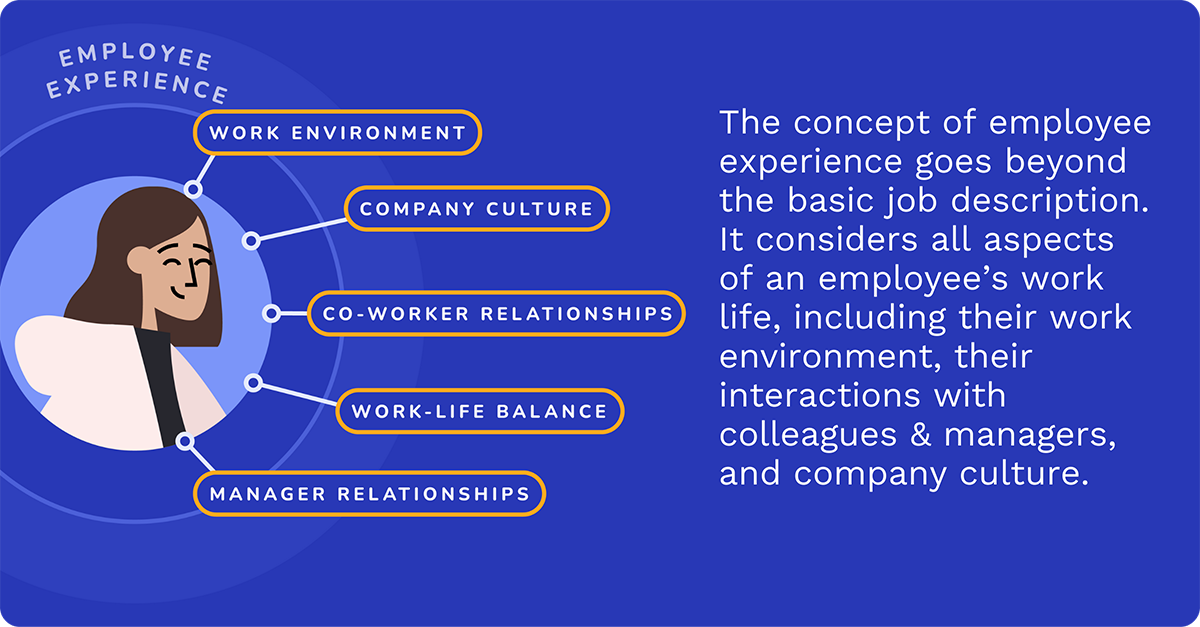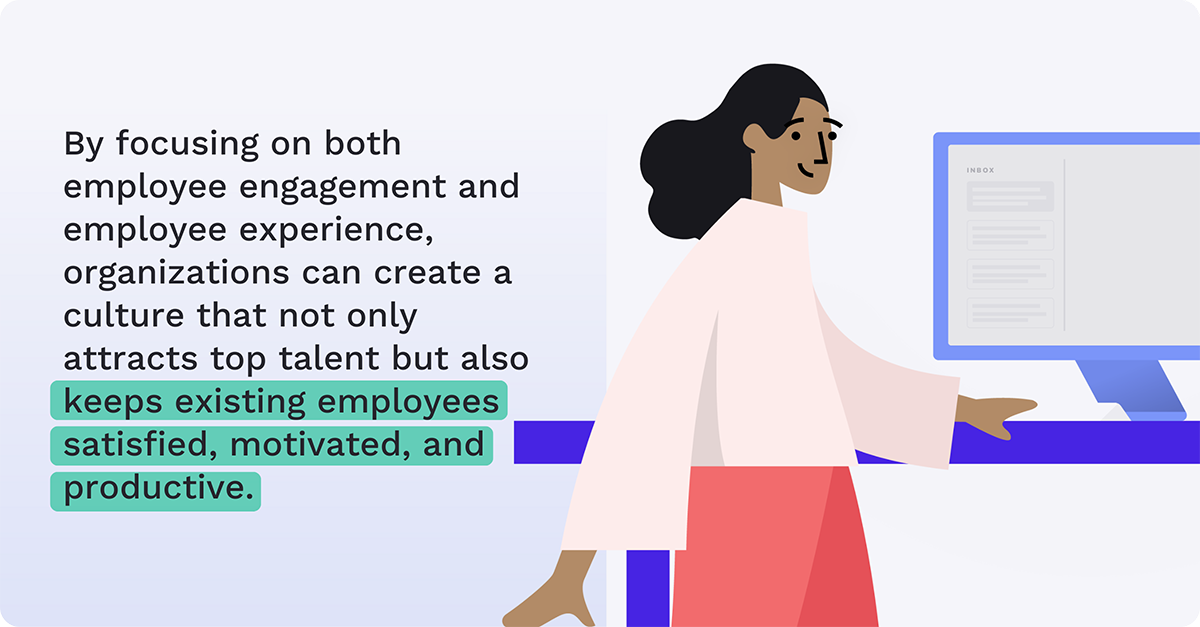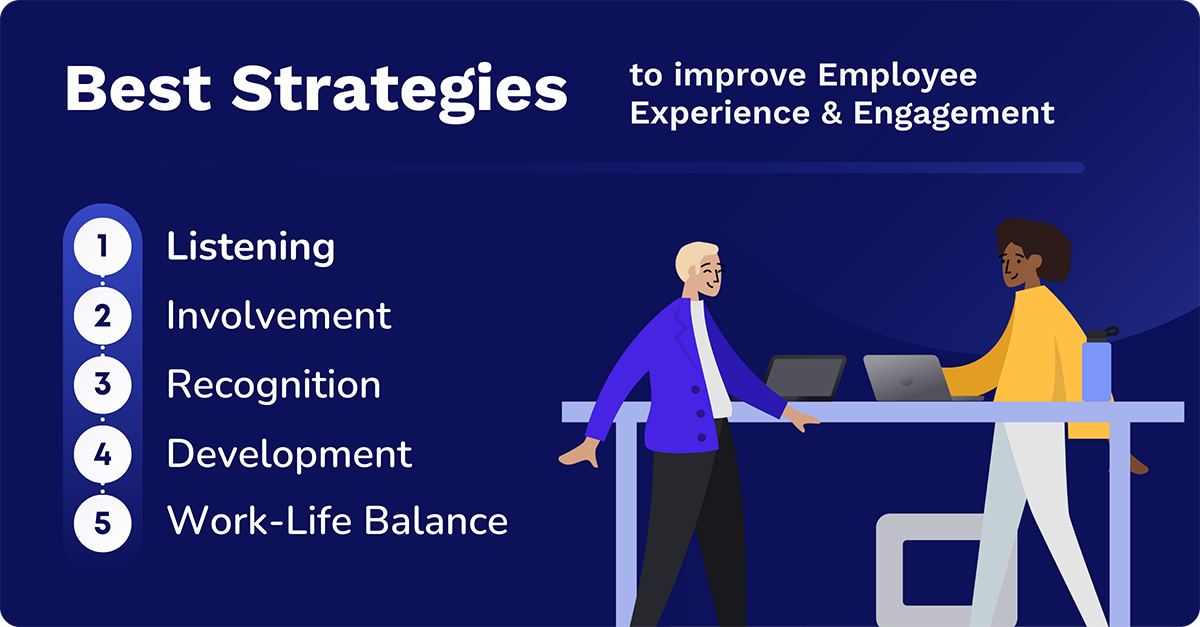What do you know about employee experience vs employee engagement? They are both vitally important, but very different. Learn why and how.

.png)
It can be difficult to know what to include in an employee survey. That’s why we have created a template that you can use for FREE to ensure your employee surveys are engaging. Get the responses that will help you understand your audience.
Access NowThe dialogue that relates to employee satisfaction in the corporate sphere incorporates two central themes: employee experience (EX) and employee engagement. But how do these two concepts differ? In what ways are they interlinked? And how can corporations measure and augment these facets to foster a healthier, more harmonious workplace?
While employee engagement is entrenched in organizational operations, employee experience as a distinct and strategic focus is new. It’s not been a company consideration for much more than a decade, if that.
Intriguingly, recent 2023 research describes engagement through positive experience as “one of the most disruptive trends in recent years in employee engagement practice.” This is because it forces organizations to redefine the way they engage with their employees in a post-pandemic era.
In their research paper, Employee experience - disruptive approach to employee engagement, Vandana B Mohanty and Mangesh Lulkarni talk about employee experience as being a key part of the post-pandemic “new normal”. Their research into this defined experience as a disruptive engagement approach looks at each employee as a whole. This distinguishes it from intervention, which focuses on addressing a specific issue related to engagement. Furthermore, there is mutual responsibility because both the organization and employee must contribute to “nurture and build a stronger bond.”
But, while the experiential concept has grown from the concept of employee engagement, it doesn’t take the place of engagement.
This article looks into the world of employee experience versus engagement. You’ll learn what both are, how employee experience evolved, and how the two concepts differ from each other. You’ll also get invaluable insight into how to measure both engagement and the experiences that relate to individual employees, together with essential strategies to enhance them both.
Craft effective surveys to measure employee sentiment and boost engagement
.png)
The experience employees have throughout their work career with a particular employer is what makes employees actually want to show up to work.
By definition, employee experience refers to all the interactions an employee has during their tenure at a company. It extends from the first step of the recruitment process all the way to their departure from the organization. The goal of the organization is to create a positive employee experience that fosters overall job satisfaction and promotes a higher level of commitment and job performance.
According to Salesforce research, dedicating resources to enhance the employee experience can lead to a boost in both revenue and profits, along with a positive return on investment (ROI). Companies that directly engage with customers witnessed a revenue surge of over 50%, coupled with an impressive ROI exceeding 80% over a decade.
Yet, there is Kincentric research that indicates only 51% of employees feel that their organization is delivering the experience they promised. As a result, their Global Employee Experience Trends 2023 report examines what leaders can do to change employee expectations and create a more engaging experience for employees.
The fact is that the experience employees have encompasses every part of the employee journey, starting with the initial interaction with the organization during the hiring process. This includes the all-important onboarding experience that welcomes team members to the company and helps them integrate smoothly in their new roles. Each stage of the employee lifecycle is part of the employee experience, including their ongoing career development opportunities and eventual transition out of the organization.
The concept of employee experience goes beyond the basic job description. It considers all aspects of employees' work lives, including their work environment, their interactions with colleagues and managers, company culture, and levels of work-life fit. In a remote work setting, the employee’s experience could be defined by how the company facilitates virtual collaboration and communication, or how the organization supports team members' well-being in the virtual environment.

There is no doubt that this is a hot topic. But what’s it all about? Acknowledging the recent emergence of the employee experience, best-selling author, futurist, and keynote speaker, Jacob Morgan tells us a bit about its evolution.
In the first half of the twentieth century, the structure of many organizations was based on utility. They were given the essential tools they needed to get their jobs done — for example, a phone, a computer (maybe a typewriter prior to the era of computers), and a desk. There was nothing about leadership styles or engagement. Employees simply had to get on and do their jobs.
Then came the era of productivity when companies did whatever they could to make employees work better and faster. But it became clear that there was a real need to engage employees. This led to the era of engagement which was an enlightenment era for the business world. Morgan calls it an “era of happiness,” when employers gave their employees everything they needed to make them happy. They also introduced annual surveys.
Organizations became obsessed with the concept of happiness, spending time, money and resources to improve engagement.
“But engagement scores overall didn’t improve. Some even dropped. Leaders couldn’t see the ROI of employee engagement, which led to our current era of employee experience.”
Jacob Morgan
Rather than making employees happy, the experience is more about changing core workplace practices inside of organizations. How do employees feel working for you? What roles and resources do they have available to do their jobs? What are the spaces in which they actually work?
This assessment helps to differentiate the experience from previously paramount engagement.
The engagement concept refers to the level of an employee's passion and commitment towards their job and the organization. Engaged employees are emotionally invested in their work and the company's success. They are proactive and go the extra mile to fulfill the company's brand promise. Disengaged employees, on the other hand, may simply do the minimum required to get by.
According to Gallup’s renowned Q12 Survey on employee engagement, highly engaged employees contribute to the increase in profitability by 23% and productivity by 18%. They also have 66% better well-being levels (net thriving employees) than organizations with low engagement.
Several elements contribute to employee engagement. For instance, a sense of psychological safety in the workplace can lead to higher levels of engagement because employees feel comfortable voicing their opinions and ideas. Recognition and appreciation also play a critical role in driving engagement, as employees who feel valued are more likely to invest their efforts and maintain a high level of commitment to their work.
Moreover, it's worth noting that employee engagement is not static but fluctuates over time. Regular pulse surveys can help organizations track these changing levels of engagement and respond timely and efficiently. Offering development opportunities and ensuring a healthy work-life balance are also strong contributors to maintaining high levels of engagement.
When it comes to discussing employee satisfaction and success in a business context, the terms employee experience and employee engagement are often thrown around interchangeably. This, however, is a mistake as they represent different elements within the workplace spectrum.
The main difference between employee experience vs employee engagement lies in their respective depths and scopes. While engagement focuses primarily on the emotional enrichment of an employee's time at work, their experience is the broader term encompassing every interaction, feeling, and impression.
Furthermore, as Kincentric research shows, consistent employee experiences lead to higher engagement. This shows that, in many ways, despite their differences, the two concepts are intertwined.
“The question at this point is whether engagement can go further, or if we have reached a true upper limit. If there is any benefit to going further on this journey, how do we move engagement to new heights?”
Kincentric
Craft effective surveys to measure employee sentiment and boost engagement
.png)
It’s vital to understand the difference between these two concepts. Still, acknowledging the connection between these terms is equally important for fostering a positive work environment. In essence, employee engagement can be seen as a subset of the broader employee experience.
Consider this analogy: If an employee's journey with an organization is represented as a book, then the employee experience would be the book's full narrative. By comparison, employee engagement represents a highlight of meaningful and impactful moments within the narrative.
For employees, having a great experience fosters higher levels of engagement, and higher engagement levels can contribute to a positive experience. This shows that while these concepts are distinct, they indirectly influence each other.
We found a research study that examines the effect of employee experience on job satisfaction, psychological well-being, and organizational commitment among corporate employees. It shows that physical, technological, and cultural experiences have a significant impact and affect job engagement. For example, when contemplating the promotion of work within a virtual environment centered on a smart office, organizations should broaden positive physical experiences and optimize cultural diversity aspects to elevate both job satisfaction and engagement.
By focusing on both employee engagement and employee experience, organizations can create a culture that not only attracts top talent but also keeps existing employees satisfied, motivated, and productive. This kind of harmonious environment nurtures the development of both the individual and the organization. It stands to reason, therefore, that for a company to succeed, it must invest in both experiences and engagement. Neither can be effectively achieved in a vacuum.

It is imperative for companies striving to foster a great employee experience and positive employee engagement to understand the state of their workforce's experiences and engagement levels. This is where the practice of measuring employee experience and engagement comes into the picture.
Understanding the parameters of these two concepts is fundamental when it comes to creating an effective strategy. It's key for organizations seeking to create a thriving work environment where team members feel valued and involved. Fortunately, there are multiple ways to do this, including the use of engagement surveys, pulse surveys, and other forms of employee feedback collection.
The employee experience is a complex construct that encompasses everything the employee perceives throughout their employee journey in the organization. It includes the recruitment process, onboarding experience, work environment, and the path to develop the professional skill set.
To measure the employee experience, HR teams can utilize a combination of quantitative and qualitative methods. Quantitative measures could involve HR data, such as staff turnover rates or productivity levels. Qualitative measures would focus on survey questions designed to capture the feelings of individuals together with perceptions about their work experience.
Employee experience surveys are one common method to use. These employee surveys go beyond simple employee satisfaction and dive into the various stages across the employee lifecycle. They range from the onboarding process to their development opportunities and even work-life balance.
Employee engagement, on the other hand, is a measure of an employee's sense of connection and commitment to their organization, their work, and their fellow team members. Engaged employees are typically more productive and loyal, while disengaged employees could negatively affect team morale and overall company culture.
Engagement surveys are a common tool for measuring employee engagement. These surveys generally include questions to gauge how employees feel about their work, the leadership, and the company culture. Survey results provide the HR team with valuable people analytics that can be used to improve the work experience and climate.
These surveys often include questions that allow employees to voice concerns or suggestions, providing deeper insights into their levels of engagement. A well-designed engagement survey should be simple and relevant. But it should measure not just job satisfaction. It should also assess the employees’ cultural experience, psychological safety, and how well life fits with work.

Improving employee experience and engagement starts with creating a strong, inclusive company culture and defining a strong job description. High levels of engagement and a positive employee experience can significantly impact business success, leading to increased productivity, higher education levels, and better job performance.
Here are a few strategic steps that can help organizations achieve this.
To improve employee experience and engagement, companies need to actively listen to their employees. This involves conducting regular pulse surveys, making an effort to understand employee feedback, and taking action on the feedback to show that the company values its employees' input.
Employees feel more engaged when they are part of decision-making processes. Involving them in decision-making can provide a strong sense of ownership and engagement.
Regularly recognizing and appreciating employees for their contributions fosters a sense of belonging and motivation.
Providing opportunities for personal and career growth can drastically enhance the overall employee experience. This includes training, certificate programs and development workshops.
Encouraging a healthy work-life balance can significantly improve the employee experience. This might include offering flexible work hours, remote work options, and ensuring employees have enough time off to unwind and recharge.
Investing in strategies that improve the employee experience and engagement will lead to a more motivated, productive workforce. It's about creating a space where every team member feels valued, heard, and empowered to contribute their best.

We’ve talked about the differences between engaging employees and improving their work experience. Both rely on strong internal communications. Whether you’re improving the onboarding experiences of your new employees, ascertaining their opinions or feelings via survey feedback, or sending personalized messages to convey your appreciation, the Cerkl Broadcast platform will be your centralized hub.
The Broadcast omnichannel capability removes the need to mess around selecting channels for engagement. It improves the experience employees have because they get information and messages in the channel they are using, and it isn’t repeated in a second channel. The platform also enables you to plan the timing and frequency of your messages to ensure they reach your audience at the right time. This also increases engagement and improves the overall experience.
Broadcast allows you to segment your audience so that you don’t have to send the same message to every employee, even if it isn’t relevant. It also comes with superior analytics tools that allow you to measure message impact.
If you are serious about improving your communications strategy to ensure increased engagement and improve the experience your employees will remember, assess your existing communications plan to see how effective it is. Our strategic internal communications audit will help you do this quickly, easily, and without a fee.
You can access our free audit template here.
.png)
Craft effective surveys to measure employee sentiment and boost engagement
What is the difference between work and employee engagement? Employee engagement is the emotional commitment and involvement an individual has towards their work, organization, and goals. Work, on the other hand, refers to the tasks and responsibilities associated with a job.
What is the difference between employee engagement and employee satisfaction? Employee engagement focuses on the emotional connection and commitment to work. Employee satisfaction is a broader measure of contentment with various aspects of the job, including pay, working conditions, and relationships.
How to improve employee experience and employee engagement? To improve employee experience, focus on creating a positive workplace environment, providing growth opportunities, and enhancing overall well-being. To boost employee engagement, encourage open communication, recognize achievements, and involve employees in decision-making processes.

Craft effective surveys to measure employee sentiment and boost engagement